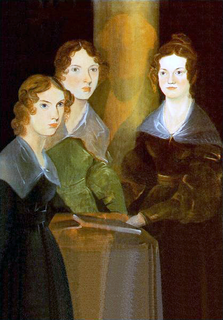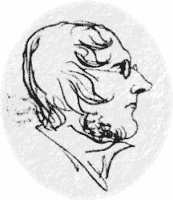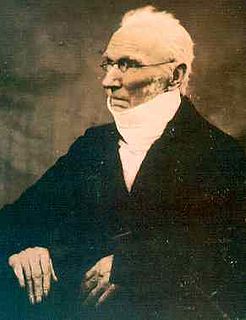 W
WThe Brontës were a nineteenth-century literary family, born in the village of Thornton and later associated with the village of Haworth in the West Riding of Yorkshire, England. The sisters, Charlotte (1816–1855), Emily (1818–1848), and Anne (1820–1849), are well known as poets and novelists. Like many contemporary female writers, they originally published their poems and novels under male pseudonyms: Currer, Ellis, and Acton Bell. Their stories immediately attracted attention for their passion and originality. Charlotte's Jane Eyre was the first to know success, while Emily's Wuthering Heights, Anne's The Tenant of Wildfell Hall and other works were later to be accepted as masterpieces of literature.
 W
WAnne Brontë was an English novelist and poet, and the youngest member of the Brontë literary family.
 W
WMaria Branwell was the mother of British writers Emily Brontë, Anne Brontë and Charlotte Brontë, and of their brother, Branwell Brontë, who was a poet and painter.
 W
WBrontë is a crater on Mercury. It has a diameter of 68 kilometres. Its name was adopted by the International Astronomical Union in 1976. Bronte is named for English writers Charlotte Brontë, who lived from 1816 to 1855, Emily Brontë, who lived from 1818 to 1848, and Anne Brontë, who lived from 1820 to 1849, and English writer and artist Branwell Brontë, who lived from 1817 to 1848.
 W
WBrontë Country is a name given to an area of south Pennine hills west of Bradford in West Yorkshire, England. The name comes from the Brontë sisters, who wrote such literary classics as Jane Eyre, Wuthering Heights, and The Tenant of Wildfell Hall while living in the area.
 W
WThe Brontë Parsonage Museum is a writer's house museum maintained by the Brontë Society in honour of the Brontë sisters – Charlotte, Emily and Anne. The museum is in the former Brontë family home, the parsonage in Haworth, West Yorkshire, England, where the sisters spent most of their lives and wrote their famous novels.
 W
WThe Brontë Waterfall is a small waterfall located about a mile south west of Stanbury, near Haworth, West Yorkshire, England. The area surrounding the waterfall is mainly moorland and farmland but is part of Brontë Country. It is an area of outstanding beauty and famous for its association with the Brontë sisters. Below the falls can be found an old stone bridge named Brontë Bridge across South Dean Beck. The bridge was destroyed in a flash flood in May 1989 and rebuilt in 1990.
 W
WThe Brontë Way is a waymarked long-distance footpath in the northern counties of West Yorkshire and Lancashire, England.
 W
WPatrick Branwell Brontë was an English painter and writer. He was the only son of the Brontë family, and brother of the writers Charlotte, Emily and Anne. Brontë was rigorously tutored at home by his father, and earned praise for his poetry and translations from the classics. However, he drifted between jobs, supporting himself by portrait-painting, and gave way to drug and alcohol addiction, apparently worsened by a failed relationship with a married woman. Brontë died at the age of 31, insisting on standing in his final moments.
 W
WThe Life of Charlotte Brontë is the posthumous biography of Charlotte Brontë by fellow novelist Elizabeth Gaskell. The first edition was published in 1857 by Smith, Elder & Co.. A major source was the hundreds of letters sent by Brontë to her lifelong friend Ellen Nussey.
 W
WCharlotte Brontë was an English novelist and poet, the eldest of the three Brontë sisters who survived into adulthood and whose novels became classics of English literature.
 W
WCowan Bridge School refers to the Clergy Daughters' School, a school mainly for the daughters of middle class clergy founded in the 1820s. It was first located in the village of Cowan Bridge in the English county of Lancashire, where it was attended by the Brontë sisters. Two of the sisters, Maria and Elizabeth died from tuberculosis in the aftermath of a typhoid outbreak at the school. In the 1830s the school moved to Casterton, a few miles away, where it was amalgamated with another girls' school. The institution survived to the twenty-first century as Casterton School.
 W
WEmily Jane Brontë was an English novelist and poet who is best known for her only novel, Wuthering Heights, now considered a classic of English literature. She also published a book of poetry with her sisters Charlotte and Anne titled Poems by Currer, Ellis and Acton Bell with her own poems finding regard as poetic genius. Emily was the second-youngest of the four surviving Brontë siblings, between the youngest Anne and her brother Branwell. She published under the pen name Ellis Bell.
 W
WArthur Bell Nicholls was the husband of the English novelist Charlotte Brontë. Between 1845 and 1861 Nicholls was one of Patrick Brontë's curates and was married to his eldest surviving child, Charlotte, for the last nine months of her life. He cared for Patrick Brontë after Charlotte Brontë's death and spent the rest of his life in the shadow of her reputation. He returned to his native Ireland, remarried and left the church.
 W
WPatrick Brontë was an Irish Anglican priest and author who spent most of his adult life in England. He was the father of the writers Charlotte, Emily, and Anne Brontë, and of Branwell Brontë, his only son. Patrick outlived his wife, the former Maria Branwell, by forty years, by which time all of their children had died as well.
 W
WStone Gappe is an 18th-century house in Lothersdale, North Yorkshire, England; it is a Grade II* listed building.